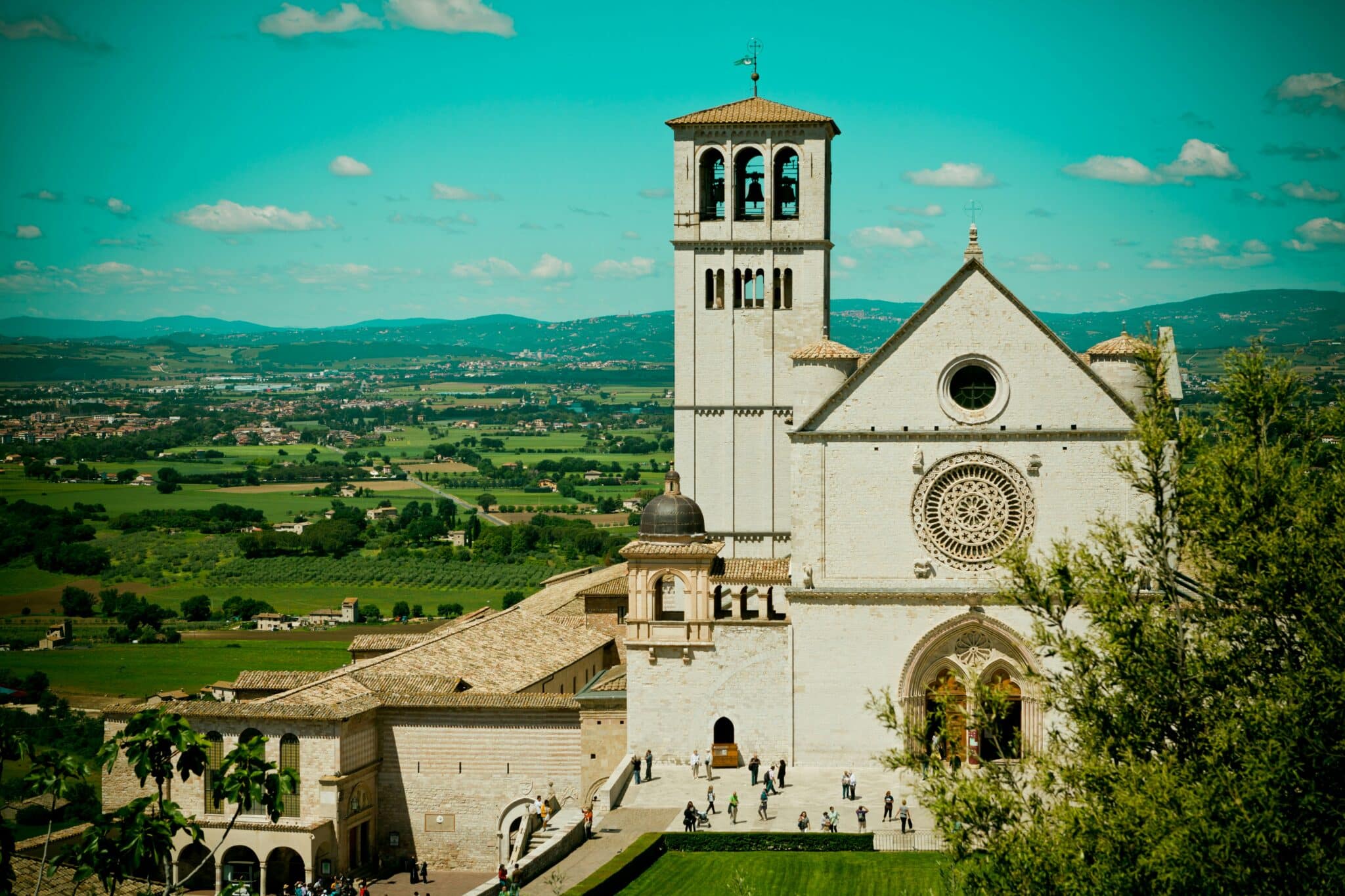Over 40 years ago, a gentle Franciscan high school teacher penned a seminal book about Saint Francis. It wasn’t a biography or a treatise on the little Poor Man of Assisi but a romantic, imaginative work that presents the saint from the inside out. Francis is a saint for seekers because he was one himself. He first set out to be a knight, fighting with the army of Walter of Brienne, was captured and taken prisoner in Perugia. He returned to Assisi, a sick and melancholy 22-year-old who didn’t know what to do with himself.
So he prayed harder and listened deeper to his dream of glory for the Lord. It eventually led him to kiss a leper, rebuild chapels, renounce his father’s wealth and privilege, embrace Lady Poverty and turn his friends into fellow travelers radically committed to the gospel. They preached by their words and by their lives.
In the end, Francis allied himself so closely with Jesus Christ that he came to share his wounds (the stigmata) and died covered only by another friar’s habit. Within a couple of years he was declared a saint by the Catholic Church, and his followers numbered into the thousands.
This is the story Father Murray Bodo, OFM, tells in his book and reflected on in an April interview with St. Anthony Messenger. Born in Gallup, New Mexico, he was an English teacher at St. Francis High School Seminary in Cincinnati, Ohio, in 1970 when Father Jeremy Harrington, OFM, editor of St. Anthony Messenger magazine, asked him to write a book about Saint Francis. Father Jeremy had heard about Franco Zeffirelli’s new movie project about Francis that became Brother Sun, Sister Moon, and wanted to capitalize on it, while presenting a thoroughly Franciscan view.
Father Murray devoted the spring and summer of 1972 to writing his book. He went to Italy to absorb firsthand something of the geography and atmosphere (“the spirituality of place”) Sts. Francis and Clare knew. In traveling to Assisi, the priest says he found he was not just moving geographically, but also moving back in time. It freed his right brain to deal with Francis, not the analytical Ph.D. side of him.
But at whom exactly was the book aimed? “When the writing was happening, I realized that I was the audience,” Father Murray remembers. “If it worked for me, then I was praying it was going to work for someone else.”
He next came to see his audience as the young men of the boarding school with whom he lived 24 hours a day, nine months of the year.
Finally came the idea that the book might have a larger reach: “I was writing somehow deeply from within. It was almost—I don’t want to be dramatic or false here—like I was an instrument of something that was coming from deep within me and from within the Franciscan tradition. From the fact of being in Assisi, I could almost feel Francis and Clare on the streets, and all of that, I think, was forming and informing the book.”
Who Is a Seeker?
Father Murray is not sure why his book appeals to seekers or even who exactly a seeker is. “Seeker, for me, describes someone for whom there is something missing and that drives them batty. They know that, if only they could find it, they would be whole.”
A seeker understands Saint Augustine’s observation that “Our hearts, O Lord, are restless until they rest in Thee.” For Father Murray, that quote sums up seekers better than any other.
“I think what I find most compelling for us today in Francis’ story is the need for and reality of reconciliation,” Father Murray says. “People are divided. Maybe it’s because of modern communications or television or whatever. We see it particularly in politics, although it’s been that way forever. There is an inability to listen to the other, and an arrogance and a pride in my own ideas.
“One of the things that happened to Francis,” the Franciscan continues, “is that all of the stuff that he thought was so important got cut out from under him, like being a knight, going to war and winning….So there is a need for reconciliation among people. And there is a need for reconciliation with nature, with the world, with the planet on which we live. Because of our technology, our power and influence we have developed a certain kind of arrogance that cannot listen to the Earth, cannot listen to the evidence of what’s happening in nature.
“In the life of Francis, I see again and again his ability to listen to the other, to listen to what’s going on. In his Testament, he says: ‘When I was in sin, it seemed to me bitter to see lepers; and then the Lord himself led me among them. And what before seemed bitter to me was turned into sweetness of soul for me.’
“No matter what part of the ideological split we embrace in the Church, or in the world, or in our own family, we need to be reconciled again on the deepest level, to trust the goodness of the other person, to go behind the appearances of things and listen—and not come to everything as big know-it-alls. This was one of the reasons Francis was suspicious of learning.”
Instead, Francis preached devotion—not meaning piety in the modern sense, but “an alacrity to do the will of God,” as Thomas Aquinas put it.
“What I find helpful in Francis,” Father Murray says, “is what he has to say when you’re feeling completely helpless: There’s no way I can help everybody in Japan [after the tsunami]; there’s no way I can solve the problems of Haiti [post-earthquake]. It’s overwhelming. But I can walk out of my metaphorical Assisi down the hill and minister to my own ‘lepers.’ I can walk out of my house and across the street and start talking to somebody. That’s Franciscan spirituality; it’s very concrete, it’s very interpersonal. Francis shows us a way to do that in his own life. And his Testament reveals to us where the seeker ended up and what gave him meaning.”
Seeking True Connection
High schoolers, Father Murray’s first audience, are natural seekers. They are discovering their talents as they plan careers. They are gathering friends of similar and diverse interests—some of whom they will keep for life. They are making lifestyle choices and dating to sort through possible life mates—or in the case of Father Murray’s seminarians, to see if celibacy might suit them. They want to know what constitutes real fulfillment, to construct a life that might yield that. They are also making religious
choices—denomination, level of commitment.
In the 1960s and ’70s, many young people were engaged in a search for “self” and “community” amidst the hippie movement and communes. That search has continued in less-publicized forms ever since, as people try to find and keep jobs in our shifting economy. Saint Francis’ desire to follow a gospel life and the dictates of his heart “is something universal, and as long as the human race exists there will be that,” Father Murray says.
“I see it even today in our own time, when people are so connected they have cell phones glued to their ears like chips in their brains….But I wonder sometimes if they are connected. On one level they’re connected, the level of information. They ‘touch base,’ as they say, with another person and make sure someone is out there.
“Francis did that. His father was a cloth merchant, and they were like the newspapers of the day. They traveled and would come back and give people all the news. And Francis was caught up in all of the news his father brought back. He thought the more he knew, the better he’d feel. But that didn’t work for Francis. He had that deeper need that was very much a part of the ’60s and ’70s, this search for the self, for meaning, for fulfillment. Francis found out that it’s not absorption in the self that matters; the more you search for yourself, the more you’re going to lose it. He learned that this is exactly what Jesus said: If you lose yourself, you’ll find yourself.
“And he lost himself in the other, in the voice of Christ from the San Damiano crucifix; he also lost it with lepers. It was as in the prayer attributed to him: ‘It is in giving that we receive.’ And as soon as he met the other, he broke out of that narcissistic absorption of the self trying to find itself.”
Father Murray thinks that this is what “registers with people today, young people, all people, because if they are still trying to find ‘fulfillment’ in their own life and find the self, they’re on the wrong track. And they see in Francis someone who—once he gave up worrying about himself and found the other, especially the Other, God, but also the other person, nature, things around him—started to come out of himself. He began to feel all the things that he wanted to feel when he was trying to make them happen.”
Seeking the Father
A common theme in literature is the search for the father. Early on, young readers may have gravitated to Father Murray’s book because it talks about the young Francis’ struggle to break away from his father and set off on his own path.
“It’s especially true of young men, young boys: this whole thing between the father and the son, and the need to find your own way, to break with your father,” says the Franciscan. “I think a lot of that was happening at the time that this book came out, and in the decade before it [the ’60s]. Young people were going in a different direction than their parents were going in, so they needed some kind of affirmation or legitimacy for what they were trying to do and what they were looking for. And Francis seems to be someone who in his own time did that.
“He went against the mores and the traditions of Assisi itself. In that medieval city, the merchant class was rising. But there were still classes: There was the aristocracy (the feudal lords), the clergy and then the poor—you’ll always have the poor. They were in the lower part of the city, and most of them down the hill, close to where he lepers lived on the plain below Assisi.
“Francis, then, is someone who was breaking with what that society was valuing most, which was money and power and commercialism. Francis’ father was one of the most significant merchants in the city. And Francis breaks with that—not because he wanted to hurt his father, or his mother, or because he was trying to make some statement, but because something happened deep within his own heart.
“And he had to follow that. This call of God from within became more real to him than what his father and those around them valued. The reality of God in the poorest of the poor became more real to him than the world he grew up in. Instead of believing in what his father believed in, he decided to follow this other reality. Francis was one of those people who, once he got something, he carried it out. He heard the word of God, and then he acted upon it.”
Revising While Keeping the Voice
For the 40th anniversary of Francis: The Journey and the Dream, Father Murray had feared that a great deal in the book would need to be updated, but was pleasantly surprised so little had to be changed. “The most important thing to me in that book is the voice, a consistent voice throughout. I didn’t want to mess with that because it was almost like something inspired….In another sense, I have ‘re-written’ that book in all the other things I’ve written about Saint Francis, such as The Way of St. Francis and Tales of St. Francis.”
It is the poetic, imaginative aspects of the original book that have kept it from being dated. “There’s something in the vision of that book. I don’t mean that in a mystical sense, but simply because it came from the same place poetry comes. You know, every time I try to talk about this, I start sounding more important than I am. But I really had this sense I was somehow inside of Francis.
“I felt almost like a novelist for whom a character comes totally to life and he or she is somehow moving on the page. One of my fears when writing this book was that I wouldn’t be able to keep writing, but every day this character, this Francis, seemed to be leading me where he wanted to go.”
Father Murray had plumbed Francis’ emotional life, St. Anthony Messenger Editor Father Jeremy recognized. He had exposed Francis’ “doubt, fear, loneliness, pain, discouragement as well as his enthusiasm for life and his brothers, wonder, joy and gratitude for people and all creation.”
Writing this anniversary edition, Father Murray has found the same voice coming back to him, which stuns him. “It’s as if I went inside to check on Francis and found that he’s alive and well, still there.”
Francis: The Journey and the Dream has taken on a life of its own, says Father Murray, as if a child of his “got out there and is now teaching me!” He admits to learning this while preparing this revision. “I thought I knew this thing I created, but somehow now it was calling me to remember something that I should remember and to know something I didn’t know I knew. Suddenly I was stunned by how much Jesus is in this book. Jesus is all over Francis: The Journey and the Dream.”
Journeys and Dreams
The Afterword of this book talks of dreams and journeys supporting one another. The 74-year-old Franciscan priest, whose hair and beard now contain more white than gray, says this has been very true for him. “I am a person who is always on a journey. Even as a boy seven or eight years old,
I’d take my little suitcase and stand on the road, waiting for someone to pick me up and take me somewhere.
“I see it as an image of the spiritual life. If you’re too much focused on the dream, on the contemplative thing, on the vision, it can easily lead to self-absorption and navel-gazing. And that’s why I’m so attracted to Francis, because he didn’t do that. He took that dream, that vision, and he acted upon it. He went on a journey; he was itinerant.
“You can define the early friars by four elements: poor, itinerant, preaching, brothers of penance. All of those elements are a part of the Franciscan life. But, on the other side, if you’re too much on the journey, and it’s not sustained by a contemplative side somehow, that gets to be very superficial. The journey itself becomes more important than the end, the point to which you are hopefully journeying.
“You don’t have to go to Assisi or go to a far place or anything like that. Even when you go to the person next door and say, ‘Good morning,’ a journey is happening, a breaking out of self-absorption and into an encounter with the other. You need to balance the two: time in prayer and time in journeying.”








